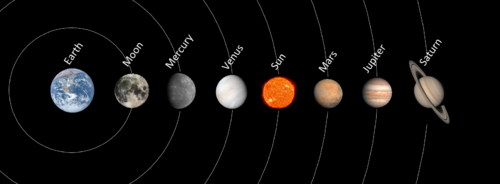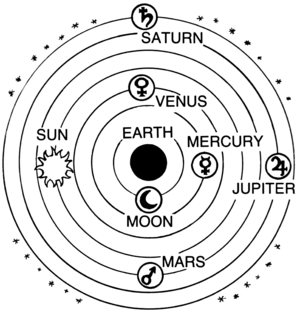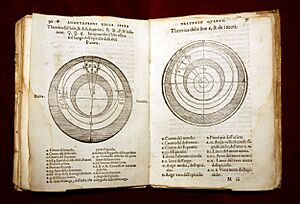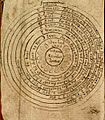Geocentrism facts for kids
Geocentrism is an old idea that says the Earth is fixed and sits right at the center of the Universe. People who believed in geocentrism knew the Earth was round. Before the 16th century, most people thought this was true.
From Earth, it really looks like the Sun and stars are moving around us. An Ancient Greek astronomer named Ptolemy wrote a very detailed book. It explained how the round Earth was surrounded by everything else moving in the sky. For many centuries, from Ptolemy's time (around 200 AD) until the 1500s, educated people believed in Ptolemy's geocentric theory.
Later, from the 1400s to the 1600s, other astronomers like Copernicus, Galileo, and Kepler found new evidence. They showed that the Earth is not fixed. Instead, it moves around the Sun. This new idea is called heliocentrism.
Today, we know that geocentrism is incorrect. However, some people still believe in it. In the United States, a study by the National Science Foundation found that about 25% of Americans believe in geocentrism.
Contents
The Earth at the Center
Ptolemy's Universe Model
Ptolemy believed the Earth was a sphere in the middle of the universe. He noticed that at any time, about half the stars were visible above the horizon and half were below. He thought this could only happen if the Earth was exactly in the center. If the Earth was far from the center, the number of visible stars would not be equal.
In Ptolemy's system, each planet moved in a special way. It used two main circles: one called a deferent and another called an epicycle. Imagine a big circle, the deferent. Its center was a bit away from the Earth. This helped explain why seasons had different lengths.
Then, a smaller circle, the epicycle, was attached to the deferent. The planet itself moved around this smaller epicycle. At the same time, the epicycle moved along the bigger deferent circle.
How Planets Moved
These combined movements made the planets seem to move closer to and farther away from Earth. It also explained a strange observation: sometimes planets would slow down, stop, and even appear to move backward in the sky. This backward movement is called retrograde motion. After a while, they would reverse again and move forward normally.

Ptolemy believed the universe was made of several spheres, one inside the other. From the Earth outward, he thought the order of these spheres was:
- Moon
- Mercury
- Venus
- Sun
- Mars
- Jupiter
- Saturn
- Fixed Stars (all the stars that seemed to stay in the same place relative to each other)
- Primum Mobile (meaning "First Moved," which was the outermost sphere that made everything else move)
Related pages
Images for kids
-
This drawing from an Icelandic manuscript dated around 1750 illustrates the geocentric model.
See also
 In Spanish: Teoría geocéntrica para niños
In Spanish: Teoría geocéntrica para niños






